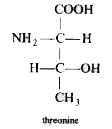Amino acid that does not contain chiral centre is :
Alanine
Leucine
Valine
Glycine
The correct Answer is:D
To determine which amino acid does not contain a chiral center, we first need to understand what a chiral center is. A chiral center, or chiral carbon, is a carbon atom that is bonded to four different atoms or groups.
Let's analyze the given options one by one:
1. Aniline: Aniline has the structure where the central carbon is attached to:
- A carboxyl group (COOH)
- An amino group (NH2)
- A hydrogen atom (H)
- A phenyl group (C6H5)
Since the central carbon is attached to four different groups, it is a chiral center.
2. Leucine: Leucine has the structure where the central carbon is attached to:
- A carboxyl group (COOH)
- An amino group (NH2)
- A hydrogen atom (H)
- An isobutyl group (C4H9)
Again, the central carbon is bonded to four different groups, making it a chiral center.
3. Valine: Valine has the structure where the central carbon is attached to:
- A carboxyl group (COOH)
- An amino group (NH2)
- A hydrogen atom (H)
- An isopropyl group (C3H7)
The central carbon here is also bonded to four different groups, indicating it is a chiral center.
4. Glycine: Glycine has the structure where the central carbon is attached to:
- A carboxyl group (COOH)
- An amino group (NH2)
- Two hydrogen atoms (H)
In this case, the central carbon is not bonded to four different groups; it has two hydrogen atoms, which means it does not have a chiral center.
Based on this analysis, the amino acid that does not contain a chiral center is Glycine.
Final Answer: Glycine (Option D)
---
- A carboxyl group (COOH)
- An amino group (NH2)
- A hydrogen atom (H)
- A phenyl group (C6H5)
Since the central carbon is attached to four different groups, it is a chiral center.
- A carboxyl group (COOH)
- An amino group (NH2)
- A hydrogen atom (H)
- An isobutyl group (C4H9)
Again, the central carbon is bonded to four different groups, making it a chiral center.
- A carboxyl group (COOH)
- An amino group (NH2)
- A hydrogen atom (H)
- An isopropyl group (C3H7)
The central carbon here is also bonded to four different groups, indicating it is a chiral center.
- A carboxyl group (COOH)
- An amino group (NH2)
- Two hydrogen atoms (H)
In this case, the central carbon is not bonded to four different groups; it has two hydrogen atoms, which means it does not have a chiral center.
Similar Questions
Knowledge Check
- Question 1 - Select One
Which amino acid does not contain chiral centre ?
AValineBLeucineCGlycineDIso-leucine - Question 2 - Select One
Amino acids are least soluble
Aat pH around 7Bat pH 7Cat their isoelectric pointsDnone of these
An amino acid is
View SolutionOne of the following amino acids does not contain sulfur
(a) Tryptophan
(b) Methionine
(c) Cysteine
(d) HomocysteineView SolutionThreonine is a naturally occurring amino acid that contains two stereogenic centers.

Label the two stereogenic centers in threorine.View SolutionAmino acids are absorbed in -
View SolutionIdentify and indicate the presence of centre of chirality, if any, in the following molecule. How many stereoisomers are possible for those containing chiral centre ?
1,2-dichloropropane.View SolutionIdentify and indicate the presence of chirality, if any in the following molecule. How many stereoisomers are possible for those containing chiral centres? 3-Bromopent-1-ene.
View Solution

